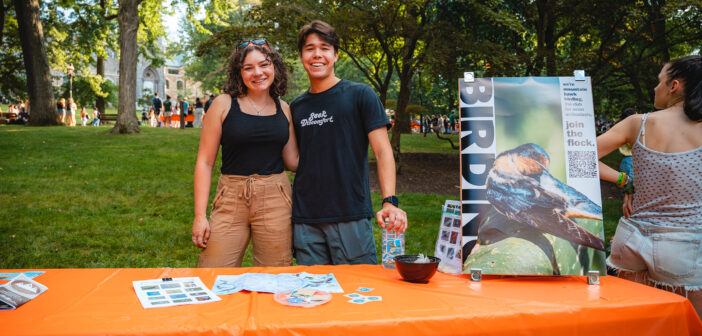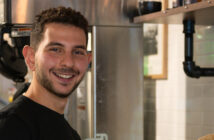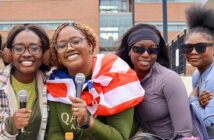Holly Fasching, ‘26, a Pennsylvania native, discovered her love for birds while hiking in the Pocono Mountains with her dad when she was growing up.
This passion sparked a deeper interest in conservation and the environmental health of her surroundings, which she has carried into college through her involvement with the Mountain Hawk Birding Club.
With a focus on local wildlife and environmental sustainability, the club offers bird watching opportunities to inspire a deeper appreciation for nature.
In April, the club will celebrate a milestone — a year of growth since its debut at the Lehigh Sustainability Fair. From its first tabling event to now, the group has built a community of birding enthusiasts, offering a shared space for the interest.
Barbara Malt, a former Lehigh psychology professor, is the club’s co-advisor. She said she originally connected with Fasching through their shared interest in birds.
Malt also said she suggested Fasching connect with the National Audubon Society, a nonprofit organization that helps bring birding chapters to college campuses.
According to its website, the society’s mission is to connect people to nature through birds and encourage conservation of natural lands among younger generations.
Fasching said she had always wanted to get involved in a birding club but didn’t know where to start. When she discovered other people on campus had similar interests, and that the society offered resources to make it a reality, a longtime desire was fulfilled.
“I was so excited because it was something I never even realized was an option,” Fasching said. “I had kind of realized…, ‘This is a dream.’”
Malt said the club is still in the works, as it needs to gain college recognition before applying to become an Audubon campus chapter or affiliate.
However, she said, the National Audubon Society will soon be the parent organization of the Birding Club, focusing on birds and their habitats, engaging people in conservation, and fostering an understanding of nature through the lens of birds.
Malt also said the diversity on college campuses offers an opportunity to engage a broader and more diverse audience.
Once the National Audubon Society affiliation is approved, the club can receive additional funding for projects. One of the club’s key goals for the upcoming year is to address the issue of bird collisions with campus buildings.
Deirdre Murphy, an art, architecture and design professor at Lehigh, conducts research on bird migration and climate change. She also serves as the faculty advisor for the club.
Murphy said many bird strikes happen when they fly into windows, mistaking the reflections of the sky or nearby trees for clear flight paths.
Fasching said as part of this project, the club is documenting the locations on campus where bird collisions occur most frequently. They have observed about 58% of bird fatalities around large glass buildings, particularly outside the Business Innovation Building and the Rauch Business Center.
Dakota Russell, ‘26, vice president of the club, said to combat this, the club plans to advocate for window treatments to be installed on campus buildings. These treatments would make windows more visible to birds, helping to prevent fatal collisions.
Along with advocating for bird safety, the club is working to implement the iNaturalist app — a social network for people to share observations of nature — onto students’ phones to help them identify birds.
“You see a dead bird, you just snap a pic of it, upload it into iNaturalist, and it automatically identifies it for you and locates it while conducting data,” Murphy said.
Malt said there are around 250 species that occur regularly in the Lehigh Valley, but over 350 bird species if we include ones seen more rarely. The iNaturalist app would help record observations and learn more about these bird species.
Aside from this long-term project, Russell said the club plans to continue growing this spring, taking advantage of the warmer weather. Various hikes and bird walks will be organized, along with joint activities in collaboration with other clubs on campus.
For the birding trips, the group visits the Trexler Game Preserve in Schnecksville and Monocacy Creek throughout a semester.
Mackenzie Barlow, ‘28, a member of the club, said on their trips, bird identification involves narrowing down options based on what members already know. For beginners, it includes observing factors like movement, body shape and specific features.
“Sometimes we use apps to help identify (birds), but there are many resources, including bird guides and books,” Barlow said.
Barlow also said she has enjoyed past trips to Trexler because the group was able to observe birds — including large birds like turkey vultures — and other animals up close.
“It was kind of just memorable in that way of identifying birds, because I really love birds,” she said.
The club has grown since its formal recognition in December 2024, with 167 GroupMe members and around 40 people on the regular roster this year.
Fasching said it never would have occurred to her that there was so much interest in birds on campus. She finds it heartwarming to see people come together over a shared love of birds, something she has cherished her whole life.
“To be able to provide that for people and give them an avenue to nature and learning about it, learning about the world around them, has been the most rewarding part of this club,” Fasching said.






Comment policy
Comments posted to The Brown and White website are reviewed by a moderator before being approved. Incendiary speech or harassing language, including comments targeted at individuals, may be deemed unacceptable and not published. Spam and other soliciting will also be declined.
The Brown and White also reserves the right to not publish entirely anonymous comments.